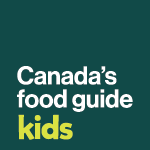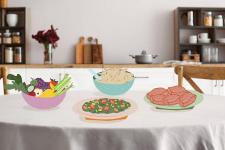Summary
Culture and food traditions are part of healthy eating. Children will learn about different cultural and food traditions through discussion. They will decorate a kitchen table activity sheet using grocery store flyers. Their decorations will reflect foods that are part of Canada’s food guide and that are important in their home.
Prep time
30 minutes
Activity duration
60 minutes
On this page
- Learning goals
- Materials
- Planning considerations
- Connecting to Canada’s food guide
- Activity instructions
Learning goals
- Practice using foods that are part of Canada’s food guide.
- Recognize that various eating patterns exist and that foods and meals from different cultural and food traditions can support overall nutritional health and well-being.
Materials
- Glue
- Scissors
- Colouring materials, such as:
- crayons
- markers
- colouring pencils
- Canada’s food guide snapshot
- Let’s have dinner together! activity sheet, one per child
- Other art materials to decorate, such as:
- yarn
- stickers
- construction paper
- Grocery store flyers, 4 to 5 flyers per group
Planning considerations
- Consider how much time you would like your group to spend on this activity.
- The Engage and Explore activities can be completed on the same day or divided into 2 sessions.
- Collect grocery store flyers.
- Aim to find some that include items from diverse cultures to reflect your group’s needs.
- If grocery store food flyers are not available, children can draw pictures instead.
Tip: Be mindful that children have varying access to food and water. These topics may be difficult for some to discuss. These discussions may induce feelings of shame or judgment by others. Before choosing to undertake this activity, make sure it is relevant to the children in your group and be prepared to address these sensitive topics.
Connecting to Canada’s food guide
- Review the following page for your activity planning:
Activity instructions
Engage
- Show the children the food guide snapshot. Explain that the food guide encourages people in Canada to eat a variety of foods each day that support nutritional health and well-being. This includes eating vegetables and fruits, whole grain foods, and protein foods regularly.
- Discuss with children that to enjoy eating, we can pick foods that match our preferences and that there are lots of options to choose from.
- Share that our preferences are shaped by many things, like our culture and food traditions. These can determine how, what, where and when we eat.
- Provide examples of different cultures and food traditions, and how they shape what and how we eat. Food traditions are common during holidays, family celebrations or on weekends. For example:
- People in some cultures may eat their meals using chopsticks and people in other cultures may use a fork. Others may eat their meals using their hands. For example, in Lebanese culture, some may use pita bread to pick up food from their plate.
- Many people have food traditions that are unique to their home. For example, some may get together at the end of summer to can and pickle foods from their garden. Others may enjoy homemade tacos for dinner every Tuesday night.
- Ask:
- What are some cultural or food traditions in your home?
- Are there specific foods that are part of these traditions?
- Do you know how these food traditions started in your home?
- Get children to reflect on their favourite food memory or favourite meals and to voluntarily share with the group.
- Be mindful that children have varying access to foods and address their questions with care and compassion.
Explore
- Explain to children that they are going to create a kitchen table depicting various foods from their culture and traditions, and Canada’s food guide. Instruct them to:
- Choose one of their food traditions or favourite meal, or practice making a unique kitchen table.
- Add anything they would need to serve the meal, like:
- plates
- utensils
- serving dishes
- a tablecloth or placemats
- Think about how they would like to serve their meal. For example:
- on individual plates
- family style: food served in big platters in the middle of the table
- buffet style: having foods laid out on the counter for everyone to serve themselves before taking a seat
Tip: Eating arrangements may vary across families and homes. Some children may not have a kitchen table or eat that way. Encourage the group to complete the blank activity sheet if this is more relevant.
- Provide each child with the Let’s have dinner together! activity sheet, grocery store food flyers, and other materials to decorate.
- Culture and food traditions play an important role in eating patterns. Instruct children to look through the flyers and invite them to look for foods that are important to their culture and background. Support children to consider which foods they have selected that are also found in Canada’s food guide such as vegetables and fruits, whole grain foods and protein foods.
- Instruct children to cut out these foods, glue them on their activity sheet, and label them.
- If children think of a food or meal that they cannot find in the flyers, invite them to draw it on their activity sheet and label it.
- Invite children to decorate their kitchen table using the additional art materials supplied.
Tip: It can be expected that some children will draw or add foods that are highly processed. It is acceptable to acknowledge that the child enjoys these foods and that these foods may be present in their household. Approach this in a non-judgmental way and avoid labelling foods as ‘good’ or ‘bad’. Thank the child for sharing the foods they included and ask the child if there are any foods on their kitchen table that can be found in Canada’s food guide. Explore different ways to address highly processed foods.
Explain
- After children have completed their Let’s have dinner together! activity sheet, post their work around the room or in the hallway.
- Divide children into small groups and have each group member present what foods they included on their activity sheet.
- Invite children to ask their group members questions about their meals and eating settings.



